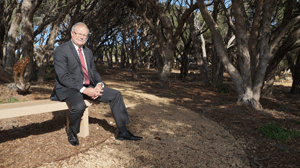 Geelong Cemetery Trust Chief Executive Officer Darryl Thomas says Queenscliff's new Moonah Walk could change the way burials are conducted worldwide
Geelong Cemetery Trust Chief Executive Officer Darryl Thomas says Queenscliff's new Moonah Walk could change the way burials are conducted worldwide There have already been two burials and 70 cremation sites purchased under the woodland canopy, despite it only being officially opened last month.
Trust Chief Executive Officer Darryl Thomas said the community’s response to the unique landscape option had exceeded expectations and was likely to shake-up the way cemeteries are planned in the future.
“When you start on something like this the plans are all nice but until the development has actually taken place you never know exactly how it’s going to turn out and I think it has exceeded our expectations.
"We’ve had great feedback from the public and great acceptance,” he said.
“Everybody was very positive once they knew what the development was going to be, that we were actually extending the Moonah plantation and not trying to deplete it.
“This Walk is actually better than anything anywhere else because it’s protecting what is existing. We’re actually helping to protect this bushland forever.
This will have international significance, not just national significance, from a cemetery point of view, absolutely.”
The environmentally sensitive design of the walk incorporates sweeping paths of crushed local limestone, with the mature Moonah trees enhanced by the planting of over 1600 additional trees, shrubs and understory plants, thus ensuring an important protected habitat for endangered plants and native animals.
The current space is limited to 70 graves and several hundred cremated remains positions.
Stage 2 of the development, still in planning, will offer the further restoration of adjacent zoodland .
“Several international cemetery magazines are publishing articles on what we’ve done here,” said Mr Thomas.
“This is a new way forward for dealing with environmentally fragile areas in cemeteries. Hopefully this will lead the way and people will have another idea on how to work with them.”
MEANTIME - works are due to start soon on the Bellarine's newest cemetery at Marcus Hill. The Trust has undertaking geo-mapping of the 39.7 ha site, on the Bellarine Highway and and will shortly begin removing areas of dense blue gum plantation to make way for indigenous yellow gum "century trees."
“We’ll plant those and let them get established so that they actually have a presence by the time we start doing major works out there," said Mr Thomas. “Getting the century trees is very important because cemeteries are there forever."